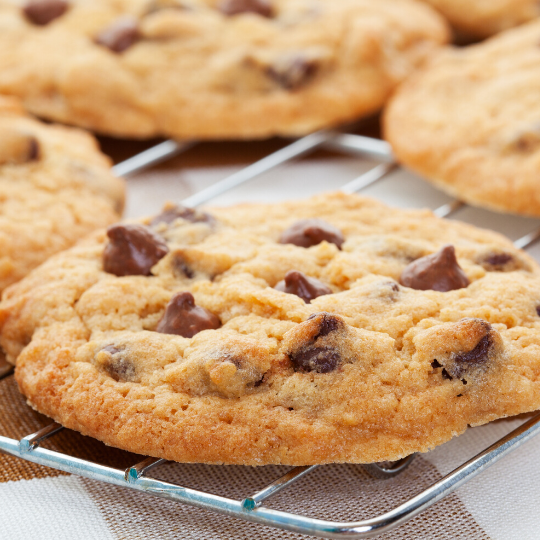What makes you lick your fingers and reach for more on a cookie?
Take the hundreds of cookie recipes out there. Factor in personal taste, which is personal, and you might find yourself wondering if the question above is even valid...
And my answer would be YES - the question is not only valid, but it has driven countless people to tirelessly work on perfecting their own cookie recipes. As a matter of fact, most people would say they like the following attributes on a cookie: thick, doughy, soft, chewy and, often times, chocolatey!

So what does it take to make my cookie dreams come true?
The secret to cookie-baking success is threefold - simplicity, a tried and tested recipe, and the quality of the ingredients.
That's right, girl! There's absolutely no need for cornstarch, apple sauce, cream cheese or hefty tasks in making delicious chocolate chip cookies! Don't sweat it, follow the recipe and you'll probably get it right!

Have you ever heard that baking is a science?
Let's not take the fun out of it and just say that baking is, first and foremost, a form of art! But baking is also a science in the sense that every ingredient in a recipe has a purpose.
Flour gives the dough structure, eggs bind the ingredients together, baking powder and baking soda make it rise, fats like butter and oil make it less chewy, and sugar sweetens and keeps it moist.
Who would have thought that science could be so sexy, am I right?

Let's break it down
Flour is the base and structure of your dough. Did anybody say protein? YES! There are 2 types of protein in flour, which, combined with water, form another protein called gluten. Through the chemical process of baking (applying high temperature), the proteins and starches in the flour form a sturdy structure that we'll later call cookie!
Tip 1 - "Bleached and unbleached flours are basically interchangeable in cookie recipes, but the bleaching process alters protein structures, resulting in less gluten formation in doughs and batters made with bleached flour. For this reason, unbleached flour is a better choice where a slightly chewier texture is desired, as in drop cookies and nut bars."
Sugar makes our lives sweet ... and cookies browner and crisper! In the baking process, the sugar caramelizes (which gives them a darker colour) and trap moisture in the dough (which makes them crispier). As the sugary dough bakes in the oven, the melting sugar causes it to soften and spread.
Tip 2 - "Brown sugar makes cookies moister and chewier than does white sugar. That's because it contains molasses (about 10 percent molasses for light brown sugar and 20 percent for dark brown sugar). The molasses adds moisture and, because it's slightly acidic, causes the proteins in the cookie dough to firm up faster, creating a chewier texture."
Fats are tenderizers. When mixed into flour, they coat some of the proteins, preventing all of it from mixing with water and forming gluten, which in turn making cookies more tender and less chewy. Now there are fats, and then there are fats. And depending on what you choose, your cookies will taste and feel very differently.
Tip 3 - "Butter contributes significant flavour, so substituting shortening or margarine for butter (or vice versa) changes the taste. It can also affect the texture of a cookie. Butter has a lower melting point than shortening or margarine, causing it to spread more during baking, so a cookie made with butter will be thinner and crisper than the same cookie made with shortening or margarine. (... ) As for salted vs. unsalted butter, the amount of salt added to salted butter varies widely, so it's best to bake with unsalted butter to better control the amount of salt."
Eggs bind our ingredients together and provide the most protein in our cookies. Through heating, the protein in the eggs expand and turn the batter into a semi-solid state. It also gives our cookies a creamy and smooth texture, all the while preventing them from becoming annoyingly crumbly.
Tip 4 - "Most cookie recipes call for large eggs. If you want to substitute a different size, note that the weight difference between each size is only about 1/4 ounce per egg. This isn't enough to make a big difference unless you're using more than six eggs in a recipe, so for most recipes, you can use egg sizes interchangeably."
Baking soda and baking powder are our rising agents in cookie recipes. When mixed in the batter, these chemical compounds make carbon dioxide bubbles that get trapped in the batter and make it rise.
Tip 5 - "Sometimes baking powder, which is a mixture of baking soda and an acidic ingredient, most commonly calcium phosphate, is added instead of baking soda to give cookies a light, cakey texture. When moistened and heated, the alkali and acid in baking powder react, neutralizing each another and giving off carbon dioxide gas, which aerates the dough, making the finished cookie puffier."

To keep it real and sciencey - we must respect the proportions called in a recipe! Too much or too little of anything will result in something completely different from your recipe. That doesn't mean you shouldn't try any modifications. But before going out on a limb and change things out, we do believe you should understand the science behind the ingredients and the baking process to avoid wasting ingredients and getting frustrated in the process!

